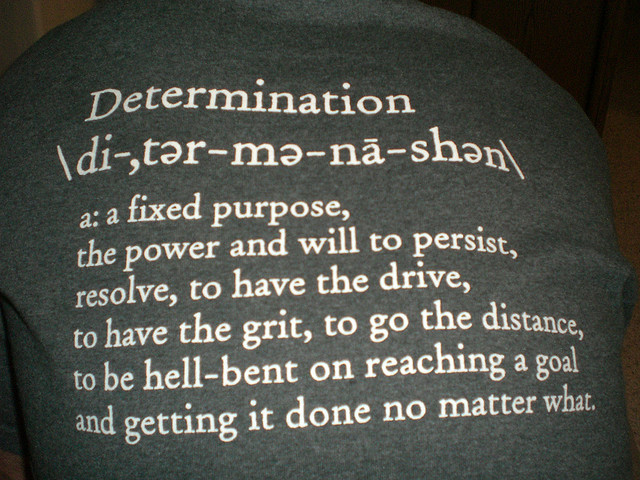
Earlier this week I talked about that point we all get to when we’ve got a long-term dream that we’re working for: that wall we all hit, where we don’t know what we’re doing anymore or why we’re even doing it. Today I’m going to give you some concrete strategies for keeping the faith when this kind of overwhelm kicks in so you can get back on track to making it happen.
Why you feel like giving up
When a dream takes a long time to build it’s easy to get lost along the way; we get so immersed in the little details that we lose sight of the bigger vision that we’re working for – we “can’t see the forest for the trees” – and we no longer see the point of continuing to work towards our dream. It’s this confusion and perceived lack of progress that is the most common reason for which people give up on their dreams; you put so much time and effort into making this dream of yours come true, but nothing seems to be happening. You’ve poured months, and in some cases years, into your project and it feels like you have nothing to show for it. And that is really demotivating for anyone. When it happens you can feel overwhelmed by a feeling of having wasted a big part of your life… all for nothing.
But this feeling isn’t reflective of reality. It’s a product of looking in the wrong place. Because it’s just not possible to put that much time, energy and effort into something – anything – and not have results. So if you’re not seeing those results, it’s because you’re not looking the right way. Shift your perspective and start looking for the evidence that you’re making progress, and you will find it.
Seven strategies for keeping the faith
Part of the reason we get stuck in this maladaptive perspective that tells us we’re not getting anywhere is because of lack of methods for measuring our own success. If you’re not clear about what your milestones are, then how will you know when you’ve reached them? And if you’re not tracking your actions and outcomes, then how do you know for sure that you’re not getting anywhere?
So that’s what I’d like you to do today. Take some time out to regroup and refocus on your dream. Find some clarity and figure out ways to track the progress that you are making. This will help you to get yourself back on track and re-inspired to achieve and become all that you know you are capable of. Here are a few strategies for helping you to do just that…
1. Remember why you started.
Take a few minutes to just sit quietly, where you won’t be disturbed and close your eyes. Think about why you wanted this dream in the first place. What does it mean to you? What are the touchstones behind this dream, and do they still ring true for you today? If you still feel that connection, then this dream is still important to you. Try and formulate a sentence that captures your “why” for this dream and write it down; this is your vision or mission statement. When you start to feel lost, take out your mission statement and remind yourself why you’re doing what you’re doing.
2. Refresh your game plan.
A lot of people get all gung-ho about their goals in January. Some of them even follow through with their plan until about February, at which point most people just give up them and never look at their plan again until the next November when they start beating themselves up over not having accomplished anything they wanted to. If you have a plan, pull it out now and take a look at it. Go through it and update it.
If you don’t have a plan, then consider making one. Start small, and just focus on your dream. Write the dream at the top of your page, and underneath it, write down your “why” from step 1. Then work backwards and figure out what you still need to do to get to where you want to be, and how you’re going to do it. Break each step down until you get to something small enough that you can do it today. And then DO IT.
3. Pay attention to your milestones.
When it comes to long-term dreams, milestones are critical to keeping yourself focused and on-track. It’s too easy to get overwhelmed when the goal is really big, so focus on the smaller sub-goals that you can achieve along the way, because each one of those victories brings you closer to the big goal, and smaller milestones are easier to grapple with than something enormous.
For example, if your goal is to win a major marathon but you’ve never run a day in your life, then concentrate on running 10 minutes every day for a whole week. Then concentrate on being able to run 5K every day. Then concentrate on being able to run 8K. Think of your milestones as building blocks to the bigger dream; the foundation has to be set before the fancy structure can be put in place. And the more solid the foundation, the stronger and longer-lasting the resulting structure will be.
4. Keep a success log.
This one seems simplistic but in some ways, it’s the most critical. Take a few minutes at the end of each day to reflect on what you’ve done over the course of the day. What steps did you take today to bring yourself closer to your big dream? Write it all down in a computer file or a paper log – just a little spiral bound notebook is fine. In another part of your notebook, write down any milestones you reached (e.g. launched web site, landed first customer, did 10 push-ups in a row). The point is to keep track of all the stuff you’ve done and what the results of those actions are. And on those days when you feel like you’re getting nowhere, look back through your notebook and realize just how far you’ve actually come and how much you actually have accomplished.
It’s easy to think we’re not getting anywhere when we’re not paying attention to the journey. But when you make it a point to record your journey, that’s when you really start to see just how much progress you have made, and what a difference you’ve been making along the way.
5. Make note of your mindset.
This is similar to the log book from step 4. At the end of every day, when you’re thinking about all the action steps you’ve taken throughout the day, I want you to think about the thing that you’re most happy with. What one action or result occurred today that you are most pleased about or proud of? Write it down at the end of today’s log entry.
6. Plan for tomorrow.
Once you’ve made your log entry for the day, I want you to shift your attention to tomorrow. What are the one to three things you are going to accomplish tomorrow with respect to your dream? You’re only allowed to choose three, maximum, but you have to get them done. You’re making a promise to yourself, and that’s just as important as a promise to someone else. Pick your three things tonight so that your subconscious mind can mull it over throughout the night, and so that you’re ready to go first thing tomorrow morning.
7. Direct your energy.
This one is similar to step 6, but instead of a daily task-list, we’re going to look at your monthly goals. So at the end of every month, I want you to set aside some time to create your milestone goal for the coming month. What one big thing are you going to accomplish this month to bring you closer to your big dream? You’re only allowed to pick one thing, and you’re going to focus your entire month on getting that one thing done. Forget about everything else – put it all on the backburner, and focus entirely on this one milestone. All of your daily tasks for this month are going to be centred on getting this done. You’ve got twelve months in a year; that’s twelve big milestones closer to your dream. It’s all about those foundation stones.
Bonus strategy:
The last thing that I want you to do is to think about how you’ve changed as a person as you’ve been working towards your big dream. What have you learned – not just technical details, or facts or processes; what have you learned about yourself as you’ve followed this path? Have you learned how resourceful you can be? How strong you really are? How much you’re able to help other people with what you’ve learned? How happy you are when you’re really focused on something you love? What has this process of following your dream done for you?
This is important, so really think about it. Because one of the most amazing things about building your dream is not what happens with the dream itself, but what you become in the process of building it. That is where your greatest results will always be found.
In summary, never give up on what you truly want in life. Dreams take time, and sometimes the road you’re walking can be bumpy and unsure. Sometimes you get knocked down and sometimes you get bruised along the way. But if it really means something to you, then pull yourself to your feet, dust yourself off and keep going. Use these strategies for keeping the faith when you are feeling lost and start thinking about giving up on your dreams. Remember your “why”, and think about everything you’ve already accomplished. You are unstoppable, and you can do this.
photo credit: Dana Lookadoo - Yo! Yo! SEO via photopin cc

















Thanks for this! Masters say to work on your dream until the death. If you are willing to do that, then it is a true dream. You also get bonus points for the next life, or something along those lines. The point is to go after it and not sit there, no matter what anyone says. If it takes long, people will tell you to give up and close shop, which is really heartbreaking, but there are ways to keep following the dream, as it is from the Ether, let us not forget. I think that those who do something else never really had it as a dream in the first place, because dreams keep you awake at night and nudge you if you are not doing anything about them. I wasn’t going to comment, but, since I was thinking if this very topic yesterday, I had to! This is clearly a sign from the Universe!!!!!!
To this, I say:
“Never give up on a dream just because of the time it will take to accomplish it. The time will pass anyway; we might just as well put that passing time to the best possible use.” ~Earl Nightingale